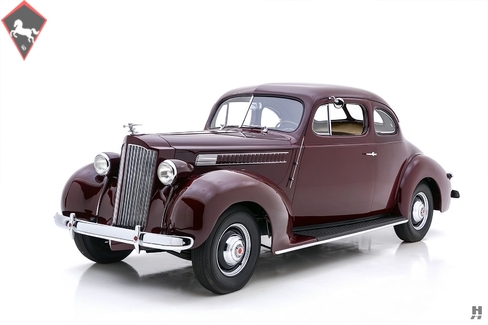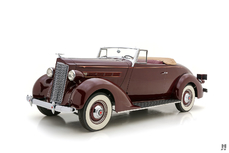Packard Six (1937-49) Coupe 1939
Allmän beskrivning :
By the late 1930s, it was finally clear to Packard’s board of directors that a mid-priced model was essential to the survival of the company. Unlike many of their competitors, Packard weathered the Great Depression relatively well, emerging bruised and battered, yet still standing. After one failed attempt at tackling the mid-price market with the 900 “Shovelnose” in 1932, Packard finally got serious with the eight-cylinder One-Twenty of 1935. But unlike the 900, the One-Twenty proved to be a runaway success. By 1937, a smaller, six-cylinder model joined the One-Twenty in the Junior line. It was the first six-cylinder automobile produced by Packard since 1927, utilizing what was, in essence, a One-Twenty engine minus two cylinders, in a similar chassis albeit with a shorter wheelbase. The six was still quite powerful, allowing for 100 mph performance in an efficient and cost-effective, and highly competitive package. For its debut year, the six-cylinder model was named the 115C, referencing its 115-inch wheelbase chassis.
Aimed squarely at Hudson, Oldsmobile, and Pontiac, the 115-C or simply “Packard Six,” was an instant sales hit, selling more than 65,000 units in its first year alone. Thanks to the six, thousands of middle-class Americans could now live the previously unattainable dream of owning a brand new Packard automobile. 1938 saw the introduction of a lengthened chassis and heavily revised sheet metal that contributed to a more balanced style, and sales continued at an impressive clip. For the 1939 model year, or Seventeenth Series in Packard parlance, much of the previous car carried over, with the most notable addition being the so-called “Handi-Shift” column-mounted gear change. The 245 cubic-inch inline-six produced an even 100 horsepower and 195lb/ft of torque. The chassis featured independent front suspension, with powerful hydraulic brakes and the robust, quality engineering that Packard buyers of all levels came to expect. Coachwork options for the Six included two coupes, two sedans, a convertible coupe, and a station wagon. Thanks to the outstanding value and quality offered by the Junior line, Packard enjoyed one of the most prosperous periods in the history of the firm.
Officially known as a Model 1700-1285, this 1939 Packard Six wears attractive two/four- passenger Club Coupe bodywork. This outstanding example of Packard’s mid-market sales leader wears a superb restoration that has seen occasional use and regular maintenance as part of a significant collection of collector automobiles. It presents in a beautiful shade of deep maroon over a taupe fabric interior, with a clean, period-correct look. Paintwork is excellent, exhibiting straight reflections in the bodywork and excellent panel fit. The brightwork is in fine order all around, with beautiful re-chromed bumpers, correctly detailed hub caps, a Goddess of Speed mascot, and of course, the proud Packard radiator grille.
The interior is a particular highlight, with the four-passenger cabin trimmed in lovely taupe twill fabric on the doors panels, front seats, and rear jump seats. The carpet and broadcloth headlining are similarly outstanding and finished to a high standard. The driver faces the original steering wheel with optional Handi-Shift column-mounted gear lever. The restored instruments sit in a stunning woodgrain-effect steel dash panel with period-correct switches and controls. Similar attention to detail was paid to the trunk upholstery, which is very well detailed.
Under the center-hinged hood sits Packard’s bulletproof 245 cubic-inch six-cylinder. Based on the legendary L-head eight design, the six offers similar levels of refinement with little sacrifice in performance. Beneath the original oil-bath air cleaner is a factory-correct Carter WA-1 downdraft carburetor. Under-hood detailing is authentic with proper wire-type hose clamps and labels and markings where appropriate. While very clean under the hood, there are some signs of regular use, with slight dulling of the painted engine block and evidence of heat cycles on some surfaces. The undercarriage is similarly presented, impressively clean and tidy while displaying evidence of enjoyment on the road.
Rarely do we encounter Packard Sixes of this era quite so nicely restored. This marvelous car benefits from recent expert care, and it would make a superb companion for casual touring and road events and is sure to satisfy any aficionado of late pre-war American classic automobiles.
Offers welcome and trades considered
https://hymanltd.com/vehicles/6551
1939 Packard Six (1937-49) Coupe is listed såld on ClassicDigest in St. Louis by Mark Hyman for $44950.
Fakta i bilen
Karosstyp : Personbil Märke : Packard Modell : Six (1937-49) Modellversion : Coupe Motorvolym : 0.0 Årsmodell : 1939 Karosstyp : Coupé Läge : Missouri
Såld
Information om säljaren
Såld
People who viewed this Packard Six (1937-49) also viewed similar Packard listed at ClassicDigest
Other cars listed for sale by this dealer
om Packard
Packard: En omfattande historiaTidiga år och stiftelse:
Grundande: Packard Motor Car Company grundades 1899 i Warren, Ohio, av James Ward Packard, William Doud Packard och George Lewis Weiss.
Pioneering Luxury: Ursprungligen producerade bilkvalitet, Packard blev synonymt med lyx, hantverk och teknisk excellens.
Anmärkningsvärda prestationer och bidrag:
Packard Twin Six: Introducerad 1916, denna V12-driven bil etablerade Packard som ett främsta lyxbilmärke.
Model Line Expansion: Packard utvidgade sin sortiment med olika modeller, inklusive sedans, kuponger, konvertibler och limousiner, som catering till välmående kunder som söker elegans och prestanda.
Tekniska innovationer: Varumärket introducerade flera innovationer, till exempel den första användningen av aluminiumkolvar, luftkonditionering och den ultramatiska automatväxeln.
Tio historiskt betydande modeller med tekniska specifikationer:
Packard Twin Six (1916):
Motor: 7.3L V12 -motor.
Prestanda: Cirka 85 hästkrafter.
Packard åtta (1930-1938):
Motor: Straight-8-motor med olika förskjutningar.
Prestanda: varierade från 90 till över 130 hästkrafter.
Packard Super Eight (1939-1951):
Motor: Straight-8-motor.
Prestanda: Tillverkad mellan 130 till 180 hästkrafter.
Packard One-Twenty (1935-1942):
Motor: Straight-8-motor.
Prestanda: Cirka 100 till 120 hästkrafter.
Packard Clipper (1941-1957):
Motor: V8 -motor.
Prestanda: allt från 135 till 185 hästkrafter.
Packard Caribbean (1953-1956):
Motor: V8 -motor.
Prestanda: varierande mellan 275 till 310 hästkrafter.
Packard Patrician (1951-1956):
Motor: Inline-8- och V8-motorer.
Prestanda: varierade från 150 till 180 hästkrafter.
Packard Hawk (1958):
Motor: V8 -motor.
Prestanda: Tillverkad cirka 275 hästkrafter.
Packard Executive (1956-1958):
Motor: V8 -motor.
Prestanda: varierande mellan 240 till 290 hästkrafter.
Packard Predictor (1956):
Motor: Konceptbil som visar design och teknik.
Prestanda: Prototypmodell.
Arv och inflytande:
Kvalitet och elegans: Packard vördades för sin exceptionella byggkvalitet, raffinerad styling och lyxfunktioner, ofta i nivå med europeiska lyxmärken som Mercedes-Benz.
Slutet på produktionen: Varumärket mötte ekonomiska kampar på 1950 -talet, vilket ledde till dess sammanslagning med Studebaker och eventuellt avbrott i slutet av 1950 -talet, vilket markerade slutet på en era i amerikanska lyxbilar.
Packard lämnade en bestående arv i bilindustrin, symboliserar elegans, teknisk excellens och ett engagemang för lyx som har beundrats och respekterats av bilentusiaster över hela världen.







